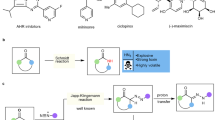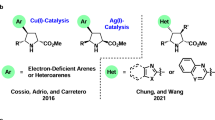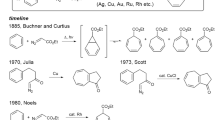Abstract
Steric character is one of the most fundamental factors to determine the reactivity of the substrate in organic synthesis. In bimolecular reaction, the sterically-bulky group situated close to the reactive center generally prevents the approach of the reaction partner retarding the bond formation. This report describes, to the contrary, significantly enhanced reactivity of 2,6-disubstituted phenyl azides observed in catalyst-free 1,3-dipolar cycloaddition with alkynes, unexpectedly reacting faster than unsubstituted phenyl azide and even more faster than unhindered alkyl azide, despite the steric hindrance adjacent to the reactive azido group. Experimental and computational studies have indicated that the steric hindrance eliciting the inhibition of resonance between azido group and the aromatic ring is the primary cause of this apparently-paradoxical phenomenon. This is the first type of steric acceleration, indicating a possibility of designing a highly reactive functional group by strategically locating it in the sterically-congested environment.
Similar content being viewed by others
Introduction
Click reaction, epitomized by copper(I)-catalyzed azide–alkyne cycloaddition, has become one of the most reliable methods to connect molecules covalently in broad disciplines including materials chemistry and chemical biology.1,2,3,4,5 In particular, strain-promoted click reaction, a copper-free variant exploiting a cyclooctyne derivative that reacts spontaneously with an azide, has realized harmless chemical modification of biomolecules in cultured cells and in living animals.6,7,8,9,10,11,12,13,14,15 Recently, we have developed the “double-click” reaction to conjugate conveniently an azido-biomolecule with a small azido compound using Sondheimer diyne (1)16 as a bis-dipolarophile (Fig. 1a).17 In this reaction, an efficient assembly of two azides takes place by virtue of the two highly strained triple bonds of 1 providing bis-cycloadduct in high yield. The practical utility of the double-click strategy has been demonstrated by efficient labeling of azido-glycoconjugates on the cell surface as well as an azido-installed recombinant protein with a fluorescein-conjugated azide. While the double-click technique has been shown comparable in labeling efficiency to the single-click procedure, experimental and computational studies presented that the monoyne intermediate, considered as the initial cycloadduct of this reaction, is remarkably reactive than the starting diyne 1, which might pose an insufficient conjugation.
Double-click reactions using a bis-reactive compound for efficient assembly of molecules.
(a) The double-click method for convenient conjugation of an azido-biomolecule with a small azido compound mediated by the Sondheimer diyne (1). (b) An initial plan of sequential double-click conjugation by diazidobenzene derivative 2 bearing two sterically-differentiated azido groups. We envisaged that the first cycloaddition with an alkyne would proceed at the less hindered side and the remaining sterically-hindered azido group could be used for the second cycloaddition with another alkyne. (c) Click reaction of diazide 2 with strained alkyne 3a unexpectedly affording 4b as the major product. This result indicated that the reaction occurred predominantly at the more sterically-hindered azido group of 2. The regiochemistry of 4b was unequivocally determined by X-ray structure analysis (CCDC 810844).
To make the double-click conjugation system more efficient, we have conceived the idea of performing a sequential double-click reaction18 using diazidobenzene derivative 2, which bears two sterically-differentiated azido groups, with an anticipation to connect first alkyne at the less hindered side and then the second alkyne at the remaining sterically-hindered side (Fig. 1b). Contrary to our expectations, however, the click reaction of diazide 2 with strained alkyne 3a proceeded predominantly at the sterically-hindered side furnishing 4b in high yield (Fig. 1c, see Supplementary Information). This unexpected but very intriguing result prompted us to elucidate the origin of enhanced reactivity of sterically-hindered azido group.
Results
The distinguished reactivity of sterically-hindered aryl azide was demonstrated through the study on the substrate scope of the azide in double-click reaction with diyne 1. First, we compared the reactivities of two typical sterically-hindered azides, 1-adamantyl azide (5b) and 2,6-diisopropylphenyl azide (5c), with unhindered benzyl azide (5a) by monitoring the reaction with 1 in methanol-d4 by 1H NMR spectroscopy. As a result, while the reaction of 1 with bulky 5b was retarded drastically (18% yield of bis-cycloadducts at 4 h) compared to that with benzyl azide (5a) (87%, 30 min), the reaction with 5c was rather hastened under the same conditions affording the product quantitatively within 5 min (see Supplementary Information). To our surprise, the second-order rate constant (k) for the reaction of 1 with 5c in methanol at 25 °C (k = 6.7 × 10−1 M−1 s−1) was ten times as large as that for 5a (k = 6.3 × 10−2 M−1 s−1).17
Exploring further the double-click reaction with a focus on the substituent effect of aryl azides more clearly showed that the bulkiness around the azido group is the key factor to enhance the reaction rate (Fig. 2, Table 1). Although all of the reactions of diyne 1 with various aryl azides 5d–5j afforded a regioisomeric mixture of bis-cycloadducts in an excellent yield, the reaction rates varied greatly depending on the substrate. Notably, the reaction with unsubstituted phenyl azide (5d) proceeded about seven times slower than 5a and, more importantly, 76 times slower than 5c (entry 1 vs 8, Table 1). para-Methoxy and para-trifluoromethyl groups showed only limited effects (entries 2 and 3, Table 1), indicating that the electronic nature of the substituent is not a decisive factor to affect the reaction rate. The reactivity of mono-ortho-substituted phenyl azides was neither enhanced nor diminished to a large extent (entries 4 and 5, Table 1). In contrast, the reactions with 2,6-disubstituted phenyl azides were dramatically accelerated, as the size of substituents became bulkier (entries 6–8, Table 1).
Reaction scheme for Table 1 .
The double-click reaction of Sondheimer diyne (1) with various aryl azides 5 was examined.
A valuable hint to understand the role of bulky substituents in enhancing the reactivity of sterically-surrounded azido group was provided from UV absorption spectra of the azides (Fig. 3a). The intensity of the peak at long-wavelength region observed for 5d (λmax = 248 nm) decreased considerably in 5c, suggesting that the conjugated state of the azido group with the aromatic ring between these azides differs substantially. The stationary structure of azides at the ground state optimized by a density functional theory (DFT) (B3LYP/6-31G(d)) method19 supported this implication indicating that the azido group of 5d lies coplanar with the benzene ring, while that of 5c is largely twisted out of the plane, forced by the bulky substituents at both ortho-positions (Fig. 3c). The calculation of rotation energy of the azido group also exhibited that 5d takes predominantly the highly-conjugated structure, showing a sharp contrast with 5c, which rather prefers the markedly-twisted conformation (Fig. 3b). Interestingly, the rotational barrier of the sterically-hindered azido group of 5c was significantly lower than that of 5d. These data have implied that the reactivity enhancement could be attributed to the inhibition of resonance20 between the aromatic ring and the azido group lowering its motional energy.
Twisted-conformation of 2,6-diisopropylphenyl azide (5c) enhancing its clickability.
(a) Absorption spectra of 5d and 5c in MeOH (100 μM). (b) Calculated rotation energy for azido group of 5d and 5c. (c) Side and overhead views of the global minima on the potential energy surface obtained for 5d and 5c. (d) Calculated transition state (TS) structures for the first cycloaddition of 1 with 5d and 5c and the side views of azides at the TS. θ indicates the rotational angle of the azido group from the aromatic plane. (e) Distortion, interaction and activation energies (in kcal mol−1) for the first cycloaddition at the B3LYP/6-31G(d). *The energy required to distort the geometry of each reactant to the transition state (TS). †The interaction energy between the distorted fragments at the TS. §The energy difference of each fragment between the optimized and the TS geometries. ¶The values including zero-point corrections (ZPCs). All calculations were performed by a density functional theory (DFT) method (B3LYP/6-31G(d)) with a GAMESS suite of program codes on a TSUBAME 2.0 system at Tokyo Institute of Technology.
To gain a mechanistic insight, we initially calculated and compared the frontier molecular orbitals21 of 1, 5c and 5d, which, however, did not afford a reasonable explanation (see Supplementary Information). Fortunately, instead, the distortion/interaction model, a generalized theory for 1,3-dipolar cycloadditions recently proposed by Houk and coworkers,22,23 led us to a comprehensive understanding. They elegantly explained the enhanced clickability of strained cycloalkynes by dividing the activation energy into distortion and interaction energies, demonstrating that the energy required to distort the 1,3-dipole and dipolarophile into their transition-state geometries is the crucial factor as well as the frontier molecular orbital interaction energy. To apply this theory, the transition state (TS) structures for the first cycloaddition of 1 with 5d and 5c, TS-d1 and TS-c1, were also obtained at the same level of the theory (Fig. 3d). The activation energy for the reaction of 1 with 5c was estimated to be 2.5 kcal mol−1 lower than that with 5d, providing a good agreement with the experimental result (Fig. 3e). The difference in distortion energies, unexpectedly, was almost equal to that of the activation energies indicating that there is little difference in interaction energies, which must include the factor of steric repulsion arising between the reactants. Considering that the difference in individual distortion energy of diyne 1 between each reaction was comparatively smaller (0.4 kcal mol−1) than that between azides (2.3 kcal mol−1), the enhanced reactivity of 5c can be mostly attributed to its decreased distortion energy compared with 5d.
The generality on the higher reactivity of bulky 5c over unhindered 5d was easily examined by reacting them with other simple alkynes. As a result, not only strained cyclooctyne derivative 3a but also unstrained alkyne such as dimethyl acetylenedicarboxylate (3b), under the Huisgen reaction conditions,24 predominantly afforded 5c-derived cycloadducts in the reaction with an equimolar mixture of 5c and 5d, clearly demonstrating the prominent clickability of doubly sterically-hindered aryl azides despite the steric barrier (Fig. 4a). On the other hand, an inverted selectivity was observed in the reaction of aryl azides with an acetylide (Fig. 4b).25 The preferred formation of 5d-derived triazole 8dc agrees well with the proposed stepwise mechanism, which should be disadvantageous for hindered substrates.
Competition between doubly sterically-hindered azide 5c and unhindered azide 5d in the reaction with various alkynes.
(a) Competition between 5c and 5d in the cycloaddition reaction with alkyne 3. (b) Competition between 5c and 5d in the reaction with acetylide generated in situ. Yields were determined based on 1H NMR analysis.
Discussion
We have unexpectedly found that sterically-congested azido group of 2,6-disubstituted phenyl azides, despite the steric hindrance, reacts significantly faster than unsubstituted phenyl azide, as well as unhindered alkyl azide in catalyst-free 1,3-dipolar cycloaddition with an alkyne. Although a similar trend was previously reported in iron-catalyzed hydrogenation of sterically-hindered aryl azides, no mechanistic explanation has been given so far.26 Our studies on substrate scope and computations have clearly shown that the enhanced reactivity of 2,6-disubstituted phenyl azides can be attributed to the increased distortability of the azido group elicited by the inhibition of resonance with the aromatic ring. The slower reaction observed for benzyl azide (5a) than 2,6-disubstituted phenyl azides can be reasonably explained by taking the contribution of the hyperconjugation between azido group and the hydrogen of alkyl chain into account. Indeed, the calculated distortion and activation energies of methyl azide in the cycloaddition with diyne 1 are also larger than those of 5c.17 All of these results suggest that the extended conjugation containing azido group makes it hard to deform to the TS structure, thus decreasing the reactivity. In contrast, the sterically-demanding aromatic azido group, in which the resonance is cancelled to some extent, achieves increased distortability, thereby exerting the high reactivity. Not only in the reaction with strained alkyne, but also with simple alkyne such as dimethyl acetylenedicarboxylate (3b), the decrease of distortion energy of doubly sterically-hindered aromatic azido group largely eclipses the steric repulsion between the substrates, thereby, in total, significantly lowers the activation energy. To our knowledge, this is the first report demonstrating the enhanced reactivity of sterically-hindered group by the effect of steric inhibition of resonance. There are some reactions accelerated by the steric assistance, but this is a novel type of steric acceleration in that the intrinsic reactivity of the azido group has been invoked by the steric participation of neighboring groups. This work indicates, though it may sound paradoxical, a possibility of designing a highly reactive functional group by strategically locating it in an appropriate sterically-congested environment.
Methods
Representative procedure for the double-click reaction
To a solution of diyne 1 (10.0 mg, 50.0 μmol) in MeOH (5.00 ml) was added a solution of 2,6-diisopropylphenyl azide (5c) (24.4 mg, 120 μmol) in MeOH (1.25 ml) at room temperature. After stirring for 30 min at the same temperature, the mixture was concentrated under reduced pressure. The residue was purified by flash column chromatography (silica-gel 10 g, CH2Cl2/MeOH = 100/1) to give a mixture of trans-6c and cis-6c (28.9 mg, 47.6 μmol, 95.4%). The ratio of trans-6c and cis-6c was determined to be 96/4 based on the 1H NMR analysis. The isomers were separated by flash column chromatography (silica-gel 10 g, CH2Cl2/MeOH = 100/1) and recrystallized. The geometry of each isomers was confirmed by X-ray crystallographical analysis (CCDC 810931 ( trans-6c) and CCDC 810838 ( cis-6c)).
References
Kolb, H. C., Finn, M. G. & Sharpless, K. B. Click Chemistry: Diverse Chemical Function from a Few Good Reactions. Angew. Chem. Int. Ed. 40, 2004–2021 (2001).
Tornøe, C. W., Christensen, C. & Meldal, M. Peptidotriazoles on Solid Phase: [1,2,3]-Triazoles by Regiospecific Copper(I)-Catalyzed 1,3-Dipolar Cycloadditions of Terminal Alkynes to Azides. J. Org. Chem. 67, 3057–3064 (2002).
Rostovtsev, V. V., Green, L. G., Fokin, V. V. & Sharpless, K. B. A Stepwise Huisgen Cycloaddition Process: Copper(I)-Catalyzed Regioselective “Ligation” of Azides and Terminal Alkynes. Angew. Chem. Int. Ed. 41, 2596–2599 (2002).
Lahann, J. Click Chemistry for Biotechnology and Materials Science, John Wiley & Sons, West Sussex, 2009.
Meldal, M. & Tornøe, C. W. Cu-Catalyzed Azide−Alkyne Cycloaddition. Chem. Rev. 108, 2952–3015 (2008).
Wittig, G. & Krebs, A. Zur Existenz niedergliedriger Cycloalkine, I. Chem. Ber. 94, 3260–3275 (1961).
Sletten, E. M. & Bertozzi, C. R. Bioorthogonal Chemistry: Fishing for Selectivity in a Sea of Functionality. Angew. Chem. Int. Ed. 48, 6974–6998 (2009).
Agard, N. J., Prescher, J. A. & Bertozzi, C. R. A Strain-Promoted [3 + 2] Azide−Alkyne Cycloaddition for Covalent Modification of Biomolecules in Living Systems. J. Am. Chem. Soc. 126, 15046–15047 (2004).
Laughlin, S. T., Baskin, J. M., Amacher, S. L. & Bertozzi, C. R. In Vivo Imaging of Membrane-Associated Glycans in Developing Zebrafish. Science 320, 664–667 (2008).
Ning, X., Guo, J. M., Wolfert, A. & Boons, G.-J. Visualizing Metabolically Labeled Glycoconjugates of Living Cells by Copper-Free and Fast Huisgen Cycloadditions. Angew. Chem. Int. Ed. 47, 2253–2255 (2008).
Jewett, J. C., Sletten, E. M. & Bertozzi, C. R. Rapid Cu-Free Click Chemistry with Readily Synthesized Biarylazacyclooctynones. J. Am. Chem. Soc. 132, 3688–3690 (2010).
Dommerholt, J. et al. Readily Accessible Bicyclononynes for Bioorthogonal Labeling and Three-Dimensional Imaging of Living Cells. Angew. Chem. Int. Ed. 49, 9422–9425 (2010).
Chang, P. V. et al. Copper-free click chemistry in living animals. Proc. Natl. Acad. Sci. U.S.A. 107, 1821–1826 (2010).
Debets, M. F., van der Doelen, C. W. J., Rutjes, F. P. J. T. & van Delft, F. L. Azide: A Unique Dipole for Metal-Free Bioorthogonal Ligations. ChemBioChem, 11, 1168–1184 (2010).
Jewett, J. C. & Bertozzi, C. R. Cu-free click cycloaddition reactions in chemical biology. Chem. Soc. Rev. 39, 1272–1279 (2010).
Wong, H. N. C., Garratt, P. J. & Sondheimer, F. Unsaturated eight-membered ring compounds. XI. Synthesis of sym-dibenzo-1,5-cyclooctadiene-3,7-diyne and sym-dibenzo-1,3,5-cyclooctatrien-7-yne, presumably planar conjugated eight-membered ring compounds. J. Am. Chem. Soc. 96, 5604–5605 (1974).
Kii, I. et al. Strain-promoted double-click reaction for chemical modification of azido-biomolecules. Org. Biomol. Chem. 8, 4051–4055 (2010).
Sanders, B. C. et al. Metal-Free Sequential [3 + 2]-Dipolar Cycloadditions using Cyclooctynes and 1,3-Dipoles of Different Reactivity. J. Am. Chem. Soc. 133, 949–957 (2011).
Schmidt, M. W. et al. General Atomic and Molecular Electronic Structure System. J. Comput. Chem. 14, 1347–1363 (1993).
Böhm, S. & Exner, O. Steric Inhibition of Resonance: A Revision and Quantitative Estimation on the Basis of Aromatic Carboxylic Acids. Chem. Eur. J. 6, 3391–3398 (2000) and references cited therein.
Fleming, I. Molecular Orbitals and Organic Chemical Reactions, John Wiley & Sons, West Sussex, 2010.
Ess, D. H. &. Houk, K. N. Theory of 1,3-Dipolar Cycloadditions: Distortion/Interaction and Frontier Molecular Orbital Models. J. Am. Chem. Soc. 130, 10187–10198 (2008).
Schoenebeck, F., Ess, D. H., Jones, G. O. & Houk, K. N. Reactivity and Regioselectivity in 1,3-Dipolar Cycloadditions of Azides to Strained Alkynes and Alkenes: A Computational Study. J. Am. Chem. Soc. 131, 8121–8133 (2009).
Huisgen, R. 1,3-Dipolar Cycloadditions. Past and Future. Angew. Chem. Int. Ed. Engl. 2, 565–598 (1963).
Kwok, S. W., Fotsing, J. R., Fraser, R. J., Rodionov, V. O. & Fokin, V. V. Transition-Metal-Free Catalytic Synthesis of 1,5-Diaryl-1,2,3-triazoles. Org. Lett. 12, 4217–4219 (2010).
Lobkovsky, E., Bill, E. & Chirik, P. J. Synthesis and Hydrogenation of Bis(imino)pyridine Iron Imides. J. Am. Chem. Soc. 128, 5302–5303 (2006).
Acknowledgements
The authors thank Ms. Ayako Hosoya for HRMS analyses. This work was partially supported by a Grant-in-Aid for Scientific Research (22850005) (S.Y.), Suntory Institute for Bioorganic Research (T.H.) and The Naito Foundation (T.H.).
Author information
Authors and Affiliations
Contributions
T.H. directed the study. S.Y. and T.H. conceived the experiment and wrote the paper. A.S. and K.K. performed the experiments. S.Y. and T.M. performed computational studies. K.J. and H.U. carried out X-ray structure analyses.
Ethics declarations
Competing interests
The authors declare no competing financial interests.
Electronic supplementary material
Supplementary Information
Supplementary Information
Rights and permissions
This work is licensed under a Creative Commons Attribution-NonCommercial-ShareALike 3.0 Unported License. To view a copy of this license, visit http://creativecommons.org/licenses/by-nc-sa/3.0/
About this article
Cite this article
Yoshida, S., Shiraishi, A., Kanno, K. et al. Enhanced clickability of doubly sterically-hindered aryl azides. Sci Rep 1, 82 (2011). https://doi.org/10.1038/srep00082
Received:
Accepted:
Published:
DOI: https://doi.org/10.1038/srep00082
Comments
By submitting a comment you agree to abide by our Terms and Community Guidelines. If you find something abusive or that does not comply with our terms or guidelines please flag it as inappropriate.







